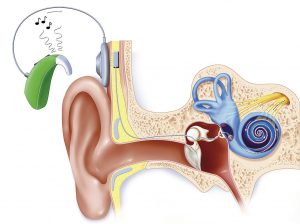
Following the cochlear implant workshop and ethics lecture, I felt inclined to reflect on the perspective of a cochlear implant user. While there are 12 million deaf people in the UK, this figure is set to increase, and there are still not many strategies to accommodate for non-hearers. The only emerging help I have witnessed are the use transcripts at the cinema, conferences or for some university lectures and also offering adjustments on work applications. I am interested in this area primarily due to unfamiliarity, I was uneducated on this area before attending the cochlear implant lecture and workshop within this module.
Furthermore, the cochlear implant is an outstanding technology, but it has its disadvantages such as reimplantation and inability for some users to perceive musical frequencies. Instead of promoting the invasive procedure, I believe that society should make implement compulsory practices like learning sign language in school to slowly accommodate for a growing community. This led me to the question ‘Are cochlear implants a sound decision?‘.
A utilitarianist would encourage non-hearers to undergo this invasive procedure to benefit the ‘greater good’, being the vast number of people that do not have impaired hearing; one person undergoing a procedure is easier than educating millions. To develop my understanding on user experience, I decided to send 8 questions to someone I know has undergone cochlear implant surgery. The questions and answers provided by Participant A are attached below.
After receiving feedback on Participant A’s experience, my perspective on this area has changed in a number of ways. I definitely agree that there needs to be more education about the implants, how they work etc. The answers provided also educated me of the fact that every user’s experience is different. I was surprised to discover the opinions surrounding cochlear implants are not generalised – Participant A stated it has helped a lot in day-to-day life while surprisingly some members in the deaf community condemn others for choosing to perceive the world audibly. Another relevant point to address is the taboo surrounding ‘deaf voices’. This unfamiliarity led me of this TikTok video uploaded by Tasha Ghouri, titled ‘Embracing my death accent‘. She recorded the entire video with her processor disconnected and made comments like ’embrace your uniqueness and show up as the person you are, no one else is you’. It is therefore important to be educated on the reality of non-hearers and encourage inclusivity.
Conclusive reflection
I really appreciated the input from Participant A and the answers encouraged me to reflect more on strategies to relieve the social drawbacks deaf people may experience. If it were in the to position I would encourage the following to meet the demands of those with impaired hearing: (1) subtitles or transcripts used for all forms of content, during live speeches etc., (2) sign language translator app, (3) patient experience talks in primary education to develop a surface-level understanding on many peoples’ reality.

To conclude, this relates to sonder and relativism, human reality is personalised and based on each person’s life experience and perspectives. Because of this it is important to be educated and offer small efforts where we can to make life easier for everyone. Most importantly, I would say that cochlear implants are a sound decision for better quality of life. The emerging technologies help bridge the disconnect between some deaf people and the ‘hearing world’ by enabling easier communication.
References
RNID. (2023). Prevalence of deafness and hearing loss. [online] Available at: https://rnid.org.uk/get-involved/research-and-policy/facts-and-figures/prevalence-of-deafness-and-hearing-loss/.
Ärzteblatt, D.Ä.G., Redaktion Deutsches (2018). Cochlea-Implantat: HNO-Ärzte stellen Weißbuch und Register vor. [online] Deutsches Ärzteblatt. Available at: https://www.aerzteblatt.de/archiv/198928/Cochlea-Implantat-HNO-Aerzte-stellen-Weissbuch-und-Register-vor.
“”Peace” in ASL colourful” Canvas Print for Sale by procrastimake | Redbubble